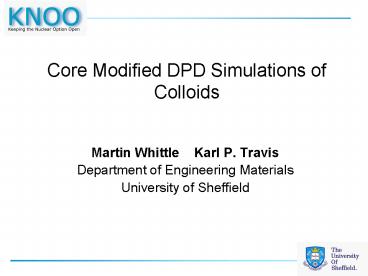Core Modified DPD Simulations of Colloids PowerPoint PPT Presentation
1 / 30
Title: Core Modified DPD Simulations of Colloids
1
Core Modified DPD Simulations of Colloids
- Martin Whittle Karl P. Travis
- Department of Engineering Materials
- University of Sheffield
2
Legacy Sludge
- Legacy wastes at Sellafield Site
- Sludges in storage tanks and ponds
- Recovery/ storage operations
- Pumping/ Squeezing
- Understanding rheology is key to optimising
mobilisation
3
Sludge samples
Yield stress up to 12 kPa Viscosity 200 Pas _at_
100 s-1
J.J. Hastings et al. / Powder Technology 174
(2007) 1824
4
Modelling approaches to simulate retrieval
Binary phase modelling for pipe flow
J.J. Hastings et al. / Powder Technology 174
(2007) 1824
5
Dissipative particle dynamics (DPD)
Each DPD particle represents a number of fluid
particles
- Forces all short- ranged
- Conservative interaction very soft.
- Dissipative depends on relative velocities vij
(vi vj)
- Random only acts between centres
Where
6
Core Modified DPD
7
Periodic boundaries
The system is surrounded with 26 images of
itself
8
Radial Distribution Function
Very sharp peak Indicates clustering
90 Colloid particles in a fluid of 59910
GW-water particles
9
Depletion interaction
Coarse graining of fluid leads to a spurious
depletion force at short range
Osmotic pressure
FD
FD
This causes rapid aggregation and has to be
compensated to obtain a stabilised colloid model
10
Measured depletion force
f2
f1
f1-f2
Theory
Agrees with theory providing a solvent size
parameter 0.5rc is used
A. Vrij, Pure Appl.Chem 48, 471, 1976
11
Depletion balance disperses clusters
12
Other interactions
- Depletion
- Lubrication (pair drag)
- Core
13
Radial distribution functions
14
Relative viscosity vs. volume fraction
Equilibrium Green-Kubo viscosities
15
Lees-Edwards shearing boundaries
Steady state linear velocity profile
Dimensionless shear rate
16
Temperature rise under shear
GW-Water
Colloid/GW-water
Needs an auxiliary thermostat
Polynomial
17
Dependence on auxiliary thermostat
R 3.0, Vf 0.3374
18
Shows main features of colloid rheology
R 3.0, Vf 0.3374
19
Change with volume fraction
20
Literature results
Foss, D. R. Brady, J. F. J. Fluid. Mech.
(2000), 407, 167-200
21
Stress response
22
Problem water-water RDFs
23
Summary
- Spurious depletion interaction can be compensated
- Core DPD code can represent a colloidal system
semi-quantitative comparison with SD/expt. - Rheology is Newtonian or pseudoplastic
- We could now investigate suitable colloidal
potentials aggregated networks that could
develop yield stress - Problems thermostatting temperature
dependence, pressure increase with f, changing
fluid phase structure with f. Can the method
reproduce macroscopic dynamic response to
external stress?
24
Acknowledgments
- Scott L. Owens, Mark Bankhead Nexia
Solutions Ltd.
25
(No Transcript)
26
(No Transcript)
27
(No Transcript)
28
Relative viscosity vs. volume fraction I
Equilibrium Green-Kubo viscosities
29
RDF at low Pe
30
Non-equilibrium viscosity

